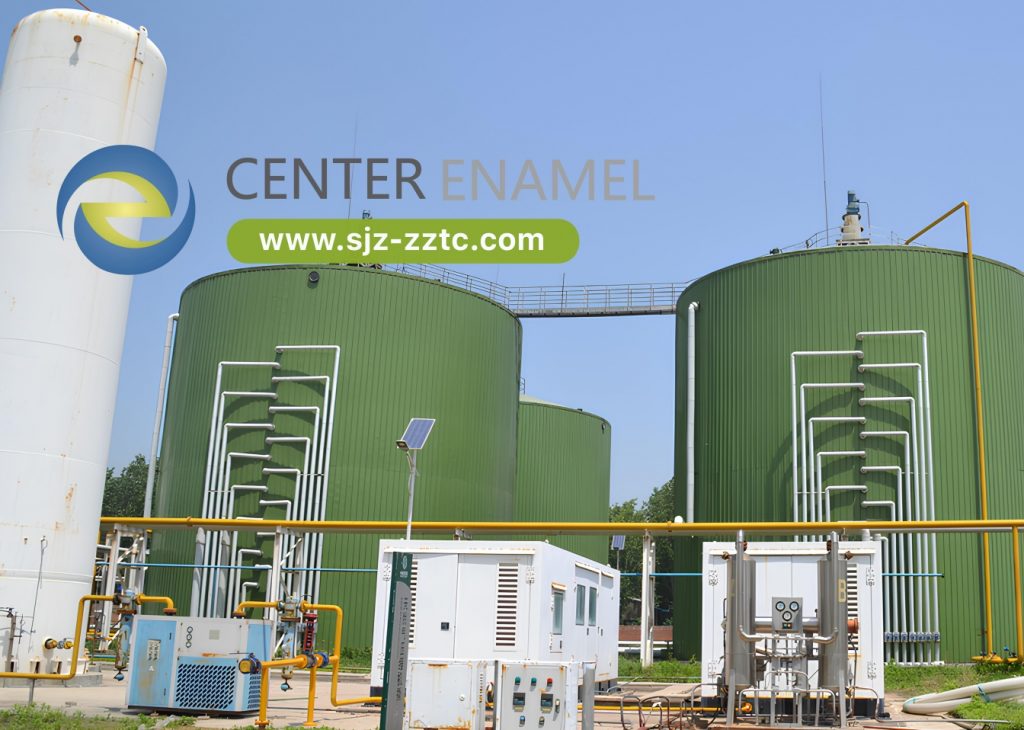CSTR Digester System for Converting Maize and Wheat Straw into Bioenergy | Center Enamel

As global energy demands continue to rise and environmental sustainability becomes an imperative, the conversion of agricultural residues into renewable energy offers a promising solution. Center Enamel’s advanced Continuous Stirred Tank Reactor (CSTR) digester system is engineered to convert maize and wheat straw into bioenergy, transforming low-value agricultural waste into a valuable resource while reducing greenhouse gas emissions and promoting sustainable farming practices.
Maize and wheat straw, byproducts of staple crop production, are often underutilized and may contribute to environmental challenges when disposed of through open burning or unmanaged decomposition. With increasing pressure to reduce carbon footprints and transition to renewable energy sources, the efficient conversion of these residues into biogas presents an attractive option. Center Enamel’s CSTR digester system leverages cutting-edge anaerobic digestion technology to process maize and wheat straw, thereby generating renewable energy and nutrient-rich digestate that can be repurposed as organic fertilizer.
The CSTR operates by maintaining a steady state where organic substrates are continuously introduced into the system, and digested material is simultaneously removed. This continuous flow process allows for consistent biogas production and optimal conversion of feedstock into methane and carbon dioxide. Center Enamel’s system is designed with robust mixing mechanisms and advanced control systems to optimize the digestion process, ensuring that the maximum energy potential of maize and wheat straw is realized.
The conversion process in the CSTR digester system begins with the pre-treatment of maize and wheat straw to enhance biodegradability. Mechanical pre-treatment techniques reduce particle size and increase the surface area available for microbial activity. In some cases, thermal or chemical pre-treatments are applied to break down complex lignocellulosic structures, thereby accelerating the hydrolysis phase.
Once pre-treated, the feedstock is introduced into the CSTR where a consortium of anaerobic microorganisms initiates the breakdown of organic matter through a series of biochemical reactions. The process involves several stages:
- Hydrolysis: Complex carbohydrates in the straw are broken down into simple sugars.
- Acidogenesis: Simple sugars are converted into volatile fatty acids and alcohols.
- Acetogenesis: Volatile fatty acids are further metabolized into acetic acid, hydrogen, and carbon dioxide.
- Methanogenesis: Methanogenic archaea convert acetic acid, hydrogen, and carbon dioxide into methane-rich biogas.
Throughout this process, the continuous stirring ensures that all reactants remain evenly distributed, reducing the formation of inhibitory compounds and allowing for stable and efficient biogas production.
Advantages of the CSTR System
The design of the CSTR digester system offers several advantages when converting maize and wheat straw into bioenergy:
- Uniform Mixing and Temperature Control:
Continuous stirring ensures consistent contact between microorganisms and the substrate. This uniformity promotes efficient conversion and prevents localized accumulation of inhibitory byproducts. - Scalability and Flexibility:
The modular nature of the CSTR design allows it to be scaled up or down based on feedstock availability and energy demand. Whether deployed on a small farm or a large agricultural operation, the system can be tailored to meet specific production needs. - Enhanced Biogas Yield:
Optimized process conditions result in higher biogas production rates. The efficient breakdown of lignocellulosic materials in maize and wheat straw means that even feedstocks with relatively low biodegradability can be effectively converted into renewable energy. - Robust Process Control:
Advanced monitoring and control systems maintain optimal operating conditions, adjusting parameters such as mixing speed, temperature, and retention time to maximize efficiency. This not only improves energy recovery but also enhances process stability and reliability.
Environmental and Economic Benefits
The implementation of a CSTR digester system for converting maize and wheat straw into bioenergy yields significant environmental and economic benefits:
- Reduction in Greenhouse Gas Emissions:
By diverting agricultural residues from open burning or unmanaged decomposition, the system helps reduce methane emissions—a potent greenhouse gas—and lowers the overall carbon footprint of agricultural operations. - Renewable Energy Production:
The biogas produced can be used directly for on-site electricity generation or upgraded to biomethane for use as a substitute for natural gas. This contributes to energy independence and reduces reliance on fossil fuels. - Nutrient Recycling:
The digestion process generates a nutrient-rich digestate that can be applied as an organic fertilizer. This not only improves soil fertility but also reduces the need for synthetic fertilizers, promoting more sustainable agricultural practices. - Economic Viability:
The dual benefits of renewable energy production and waste management enhance the economic attractiveness of the system. Farmers and agricultural businesses can generate additional revenue streams by selling excess biogas or receiving incentives for renewable energy projects.
Why Choose Center Enamel?
Center Enamel brings decades of expertise in the design and manufacture of advanced anaerobic digestion systems. Our CSTR digester system is developed using state-of-the-art technology and precision engineering to ensure that it meets rigorous international standards. Key advantages of choosing Center Enamel include:
- Engineering Excellence:
Our systems are built with robust materials and incorporate sophisticated control mechanisms to ensure long-term operational stability and efficiency. - Customization and Scalability:
We work closely with our clients to tailor our solutions to their specific requirements, whether they are small-scale farms or large industrial operations. - Commitment to Sustainability:
Our focus on environmental stewardship means that our solutions are designed to maximize renewable energy production while minimizing waste and reducing environmental impact. - Global Experience:
With a proven track record in over 100 countries, Center Enamel is recognized worldwide for our innovative solutions and commitment to quality.
For more information on how Center Enamel’s CSTR digester system can be integrated into your agricultural operations, please contact us to discuss tailored solutions that meet your bioenergy production needs.
